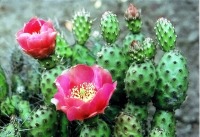
Szutorisz, Kaktusz-Világ 26: 115, 2002
(Also see Szutorisz, Succulentes 4: 17, 2005)
Herbarium; Herbarium; Herbarium; Herbarium; Herbarium; Herbarium; Herbarium; Herbarium
Details
Cladodes on this cactus are often egg-shaped and oval (or round) in cross-section. However, cladodes are variable. They range in shape and size but are generally larger than those of O. fragilis (often much larger), and flattened joints are common. Unlike O. fragilis, the cladodes do not separate easily. Spines may be present or absent, short or long, depending upon the population in question, and up to 1-1.5 cm in length.
Flowers may be anything from yellow to orange to magenta, with light-yellow, pink, or red centers. Some populations may be of mixed colors, but other populations are single-colored. The style is pale and the stigma is green or light-green. The fruit is oblong or clavate and tan when dry at maturity. Seeds are flat, whitish, and 5-6 mm in diameter.
Other Notes
O. debreczyi tends to grow on open, sloping ground in upland areas above the lower deserts; it is often found with other Opuntias such as O. trichophora and O. polyacantha. It may also occur with O. fragilis, O. zuniensis, Pediocactus simpsonii, Sclerocactus parviflorus, and Escobaria vivipara. Alternatively, this pricklypear may occur in pure stands with no other species of cactus nearby. It grows in southwestern Wyoming and across western Colorado to eastern Utah. It barely reaches into northeastern Arizona and northwestern New Mexico but is not common in these latter states. Similar plants occur on the Snake River Plains, across much of the Great Basin, and north to southern British Columbia, where they are almost invariably and incorrectly called O. fragilis or confused with O. columbiana.
O. debreczyi may have O. fragilis and O. polyacantha-like plants in its ancestry or vice versa. However, this pricklypear constitutes a stable, self-reproducing species. Wherever its origins, it is not now a hybrid of O. polyacantha and O. fragilis. Rather, it is a discrete stand-alone species. Various popular names are applied to garden forms of this Opuntia species, including O. rutila, Super Rutila, and O. polyacantha rutila.
The small plants are colorful and cold-hardy. They grow in many situations and are excellent garden plants.
For more information, see:
Szutorisz, Opuntia debreczyi species novum, (translated title) Kaktusz-Világ 26: 115, 2002















Thanks for the clarification on the opuntia debreczyi.
Hi, First description data of Opuntia debreczyi are false. The taxa was described by Szutorisz in Kaktusz-Világ 26(4): 115-117, 2002.
Kaktusz-Világ is a periodical of Hungarian Cactus Society.
Best wishes
Zoltán Lukoczki, former chief editor of Kaktusz-Világ
Zoltán,
Thanks for your note. I will look into this.
Joe